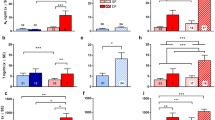Summary
Males of a natural population of Antechinus stuartii (Marsupialia) were injected at the beginning of their short, synchronous breeding period with one of twelve gamma-emitting nuclides which are individually recognizable by their unique spectial properties. This label passed to the females during ejaculation and was identified when the females were captured and counted in a whole-body counter. This technique established mating success of males and provided an estimate of reproductive success.
Similar content being viewed by others
References
Adams F, Dams R (1970) Applied gamma-ray spectrometry, 2nd edn. Pergamon Press, Oxford
Bateman AJ (1948) Intra-sexual selection in Drosophila. Heredity 2:349–368
Bertram B (1976) Kin selection in lions and in evolution. In: Bateson P, Hinde R (ed) Growing points in ethology. Cambridge University Press, Cambridge, pp 281–301
Bradley AJ, McDonald IR, Lee AK (1980) Stress and mortality in a small marsupial (Antechinus stuartii, Macleay). Gen Comp Endocrinol 40:188–200
Braithwaite RW (1974) Behavioral changes associated with the population cycle of Antechinus stuartii (Marsupialia). Aust J Zool 22:45–62
Braithwaite RW, Lee AK (1979) A mammalian example of semelparity. Am Nat 113:151–155
Cockburn A, Scott MP, Scotts D (1985) Inbreeding avoidance and male-biased natal dispersal in Antechinus spp. (Marsupialia: Dasyuridac). Anim Behav (in press)
Currie LA (1968) Limits for qualitative detection and quantitative determination. Anal Chem 40:586–593
Foltz DW, Hoogland JL (1981) Analysis of the mating system in the Black-tailed prairie dog (Cynomys ludovicianus) by likelihood of paternity. J Mammal 62:706–712
Hanken J, Sherman PW (1981) Multiple paternity in Belding's ground squirrel litters. Science 212:351–353
International Atomic Energy Agency (1963) A basic toxicity cassification of radionuclides. IAEA, Vienna
International Commission on Radiological Protection (1979) Limits for intakes of radionuclides by workers. ICRP publication 30, part 1. Pergamon Press, Oxford
International Commission on Radiological Protection (1981) Limits for intakes of radionuclides by workers. ICRP publication 30, supplement to part 2. Pergamon Press, Oxford
Lee AK, Bradley AJ, Braithwaite RW (1977) Corticostcroid levels and male mortality in Antechinus stuartii (Macleay). In: Stonehouse B, Gilmore D (eds) Biology of marsupials. Academic Press, New York, pp 209–220
May RM, Robertson M (1980) Just so stories and cautionary tales. Nature 286:327–329
McCracken G, Bradbury J (1977) Paternity and genetic heterogeneity in the polygynous bat, Phyllostomus hastatus. Science 198:303–306
National Academy of Sciences Committee on the Biological Effects of Ionizing Radiation (1980) The effects on populations of exposure to low levels of ionizing radiation: 1980. National Academy Press, Washington, DC
Schultz V, Whicker FW (1982) Radioecological techniques. Plenum Press, New York
Schwartz OA, Armitage KB (1980) Genetic variation in social mammals: The marmot model. Science 207:665–667
Scott MP (1984) Reproductive ecology of Antechinus (Marsupialia: Dasyuridae). PhD thesis, Harvad University, Cambridge, Mass
Scotts D (1983) Social structure of Antechinus stuartii. Hons thesis, University of Monash, Clayton, Vic
Sherman P (1977) Nepotism and the evolution of alarm calls. Science 197:1246–1253
Tamarin RH, Sheridan M, Levy CK (1983) Determining matrilinial kinship in natural populations of rodents using radionuclides. Can J Zool 61:271–274
Trivers RL (1972) Parental investment and sexual selection. In: Cambell B (ed) Sexual selection and the descent of man. Aldine, Chicago, pp 136–179
United Nations Scientific Committee on the Effects of Atomic Ratiation (1982) Ionizing radiation: Sources and biological effects. United Nations, New York
Wolff JO, Holleman DF (1978) Use of radioisotope labels to establish genetic relationships in free-ranging mammals. J Mammal 59:859–860
Wood DH (1970) An ecological study of Antechinus stuartii (Marsupialia) in a south-east Queensland rain forest. Aust J Zool 18:185–207
Author information
Authors and Affiliations
Rights and permissions
About this article
Cite this article
Scott, M.P., Tan, T.N. A radiotracer technique for the determination of male mating success in natural populations. Behav Ecol Sociobiol 17, 29–33 (1985). https://doi.org/10.1007/BF00299424
Received:
Accepted:
Issue Date:
DOI: https://doi.org/10.1007/BF00299424




